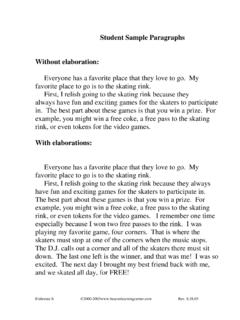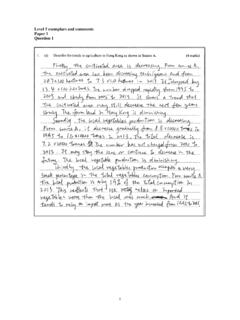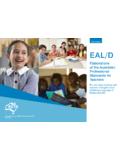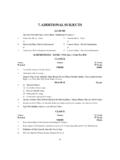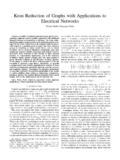Transcription of Standards for Mathematical Practice: Commentary and ...
1 Standards for Mathematical Practice: Commentary and elaborations for K 5c Illustrative Mathematics12 February 2014 Suggested citation:Illustrative Mathematics. (2014, February 12).Stan-dards for Mathematical Practice: Commentary andElaborations for K , discussion of the elaborations and related top-ics, see the Tools for the Common Core blog: , 12 February 2014, comment at Standards forMathematical Practice,annotated for the K 5classroomThe Common Core State Standards describe the Standards for Math-ematical Practice this way:The Standards for Mathematical Practice describe vari-eties of expertise that mathematics educators at all lev-els should seek to develop in their students. These prac-tices rest on important processes and proficiencies" withlongstanding importance in mathematics education. Thefirst of these are the NCTM process Standards of problemsolving, reasoning and proof, communication, represen-tation, and connections. The second are the strands ofmathematical proficiency specified in the National Re-search Council s report Adding It Up: adaptive reasoning,strategic competence, conceptual understanding (com-prehension of Mathematical concepts, operations and re-lations), procedural fluency (skill in carrying out proce-dures flexibly, accurately, efficiently and appropriately),and productive disposition (habitual inclination to seemathematics as sensible, useful, and worthwhile, cou-pled with a belief in diligence and one s own efficacy).
2 In this document we provide two different ways of adapting thelanguage of the practice Standards to the K 5 this section we provide annotated versions of the standardsthat provide additional interpretation of the Standards appropriatefor K 5 classrooms. This section is intended for people who want tounderstand how the original language of the Standards applies inK the next section we provideelaborationsof the Standards :narrative descriptions that integrate the annotations from the firstsection and provide a coherent description of how the practice stan-dards play out in the K 5 , 12 February 2014, comment at Standards WITH K 5 COMMENTARY31. Make sense of problems and persevere in proficient students start by explaining to themselvesthe meaning of a problem and looking for entry points to its solution. Young students might use concrete objects or pictures to showthe actions of a problem, such as counting out and joining twosets to solve an addition problem.
3 If students are not at firstmaking sense of a problem or seeing a way to begin, they askquestions that will help them get analyze givens, constraints, relationships, and goals. Theymake conjectures about the form and meaning of the solution andplan a solution pathway rather than simply jumping into a solutionattempt. They consider analogous problems, and try special casesand simpler forms of the original problem in order to gain insightinto its solution. They monitor and evaluate their progress and For example, to solve a problem involving multidigit numbers,they might first consider similar problems that involve multiples often or one hundred. Once they have a solution, they look back atthe problem to determine if the solution is reasonable and accu-rate. They often check their answers to problems using a differentmethod or course if necessary. Older students might, depending on thecontext of the problem, transform algebraic expressions or changethe viewing window on their graphing calculator to get the infor-mation they need.
4 Mathematically proficient students can explaincorrespondences between equations, verbal descriptions, tables, andgraphs or draw diagrams of important features and relationships,graph data, and search for regularity or trends. Younger studentsmight rely on using concrete objects or pictures to help conceptual-ize and solve a problem. Mathematically proficient students check Mathematically proficient elementary students may considerdifferent representations of the problem and different solutionpathways, both their own and those of other students, in orderto identify and analyze correspondences among answers to problems using a different method, and they contin-ually ask themselves, Does this make sense?" They can understand When they find that their solution pathway does not makesense, they look for another pathway that approaches of others to solving complex problems and identifycorrespondences between different , 12 February 2014, comment at Standards WITH K 5 COMMENTARY42.
5 Reason abstractly and proficient students make sense of quantities andtheir relationships in problem situations. They bring two comple-mentary abilities to bear on problems involving quantitative rela-tionships: the ability to decontextualize to abstract a given situa- For example, to find the area of the floor of a rectangular roomthat measures 10 m. by 12 m., a student might represent theproblem as an equation, solve it mentally, and record the problemand solution as10 12 120. He has decontextualized theproblem. When he states at the end that the area of the roomis 120 square meters, he has contextualized the answer in orderto solve the original problem. Problems like this that begin witha context and are then represented with Mathematical objects orsymbols are also examples of modeling with mathematics ( ).tion and represent it symbolically and manipulate the representingsymbols as if they have a life of their own, without necessarily at-tending to their referents and the ability to contextualize, to pauseas needed during the manipulation process in order to probe intothe referents for the symbols involved.
6 Quantitative reasoning en-tails habits of creating a coherent representation of the problem athand; considering the units involved; attending to the meaning of For example, when a student sees the expression40 26, shemight visualize this problem by thinking, if I have 26 marbles andMarie has 40, how many more do I need to have as many asMarie? Then, in that context, she thinks, 4 more will get me to atotal of 30, and then 10 more will get me to 40, so the answer is14. In this example, the student uses a context to think through astrategy for solving the problem, using the relationship betweenaddition and subtraction and decomposing and recomposing thequantities. She then uses what she did in the context to identifythe solution of the original abstract , not just how to compute them; and knowing and flexiblyusing different properties of operations and , 12 February 2014, comment at Standards WITH K 5 COMMENTARY53. Construct viable arguments and critique thereasoning of proficient students understand and use stated as-sumptions, definitions, and previously established results in con-structing arguments.
7 They make conjectures and build a logical For example, a student might argue that two different shapeshave equal area because it has already been demonstrated thatboth shapes are half of the same of statements to explore the truth of their are able to analyze situations by breaking them into cases, andcan recognize and use counterexamples. They justify their conclu- For example, a rhombus is an example that shows that not allquadrilaterals with 4 equal sides are squares; or, multiplying by 1shows that a product of two whole numbers is not always greaterthan each , communicate them to others, and respond to the arguments ofothers. They reason inductively about data, making plausible argu- Students present their arguments in the form of represen-tations, actions on those representations, and explanations inwords (oral or written). In the elementary grades, arguments areoften a combination of all three. Some of their arguments applyto individual problems, but others are about conjectures basedon regularities they have noticed across multiple problems ( , Look for and express regularity in repeated reasoning).
8 Ments that take into account the context from which the data proficient students are also able to compare theeffectiveness of two plausible arguments, distinguish correct logicor reasoning from that which is flawed, and if there is a flaw inan argument explain what it is. Elementary students can con-struct arguments using concrete referents such as objects, drawings,diagrams, and actions. Such arguments can make sense and be For example, in order to demonstrate what happens to the sumwhen the same amount is added to one addend and subtractedfrom another, students in the early grades might represent a storyabout children moving between two classrooms: the number ofchildren in each classroom is an addend; the total number of chil-dren in the two classrooms is the sum. When some studentsmove from one classroom to the other, the number of studentsin each classroom changes by that amount one addend de-creases by some amount and the other addend increases by thatsame amount but the total number of students does not older elementary student might use an area representation toshow why the distributive property , even though they are not generalized or made formal untillater grades.
9 Later, students learn to determine domains to which anargument applies. Students at all grades can listen or read the ar- For example, young students may believe a generalizationabout the behavior of addition applies to positive whole numbersless than 100 because those are the numbers with which theyare currently familiar. As they expand their understanding ofthe number system, they may reexamine their conjecture fornumbers in the hundreds and upper elementary grades, students return to their con-jectures and arguments about whole numbers to determinewhether they apply to fractions and decimals. For example, stu-dents might make an argument based on an area representationof multiplication to show that the distributive property applies toproblems involving of others, decide whether they make sense, and ask usefulquestions to clarify or improve the , 12 February 2014, comment at Standards WITH K 5 COMMENTARY64.
10 Model with proficient students can apply the mathematics theyknow to solve problems arising in everyday life, society, and theworkplace. In early grades, this might be as simple as writing an For elementary students, this includes the contextual situationsthey encounter in the classroom. When elementary students arefirst studying an operation such as addition, they might arrangecounters to solve problems such as this one: there are sevenanimals in the yard, some are dogs and some are cats, how manyof each could there be? They are using the counters to modelthe Mathematical elements of the contextual problem that theycan split a set of 7 into a set of 3 and a set of 4. When theylearn how to write their actions with the counters in an equation,4 3 7, they are modeling the situation with numbers andsymbols. Similarly, when students encounter situations such assharing a pan of cornbread among 6 people, they might first showhow to divide the cornbread into 6 equal pieces using a picture ofa rectangle.







